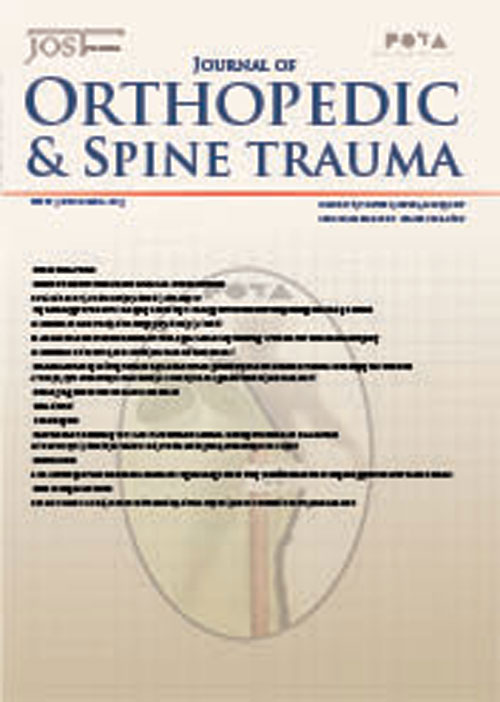فهرست مطالب

Journal of Orthopedic and Spine Trauma
Volume:7 Issue: 3, Sep 2021
- تاریخ انتشار: 1401/01/21
- تعداد عناوین: 10
-
-
Pages 77-80Background
Although there are various surgical methods for subungual glomus tumor treatment, there is no consensus on the optimal surgical approach.
MethodsWe analyzed the outcomes of 15 patients treated with partial nail plate excision technique. The medial or lateral section of the nail plate was excised longitudinally based on the tumor location. After incision of the nail bed and tumor removal, the matrix was repaired carefully.
ResultsIn this study, 15 people, including 11 men and four women, were studied. The mean onset of symptoms until diagnosis was 88 months. In the postoperative evaluation, the mean follow-up was 20 months. Two patients had recurrent tumors, and one had postoperative nail deformity.
ConclusionMeticulous nail bed repair and complete tumor excision are key treatment points needed to prevent nail deformity and recurrence.
Keywords: Glomus Tumor, Treatment, Hand -
Pages 81-84Background
This study was designed to achieve a new method as a preventive treatment for complications of growth plate fractures. In this study, we investigate the effect of intra-articular injection of anti-vascular endothelial growth factor (anti-VEGF) antibody bevacizumab on the repair process of articular cartilage in a type 4 Salter Harris injury model.
MethodsA Salter Harris injury was created on the proximal tibial growth plate of 14 rats by a 1.8 mm drill. The rats were randomly classified into two groups: group LD, administration of high-dose intra-articular injection of bevacizumab (250 μg), and group HD, administration of low-dose intra-articular injection of bevacizumab (50 μg) after injury. The rats were killed 2 months postoperatively and their tibia underwent micro-computed tomography (CT) analysis, histological assessment, and measurement of tibial bone length.
ResultsBony bar formation was observed in 71% of the samples in the high-dose group and in 100% of the low-dose group. Relative increase in physeal cartilage thickness (P = 0.007) and decrease in bony bar formation (P = 0.029) were observed significantly in the high dose group. There was no significant difference in tibia length between the two groups (P = 0.150).
ConclusionIntra-articular administration of bevacizumab demonstrated positive restorative effects. We suggest this method of treatment due to its potential of improving cartilage repair and capability to be used as a main or adjacent treatment in osteochondral defects.
Keywords: Salter-Harris Fractures, Growth Plate Fracture, Vascular Endothelial Growth Factors, Bevacizumab, Orthopedics -
Pages 85-94Background
The aim of this study was to develop a prognostic model to identify a subgroup of high-risk patients for non-healing after femoral neck fracture fixation among young adults. The model was implemented by presenting graphically as a nomogram that could be easily used in every day clinical cases.
MethodsData on a total of 129 patients were included in the current study. The mean [standard deviation (SD)] age of the participants was 42 (13) years and 28% of the patients were women. Harrell’s C statistic was used as a measure of discrimination predictive power. We calculated the Nam-D’Agostino χ2 to examine calibration for prediction models.
ResultsApproximately, 83% of fractures united uneventfully, with avascular necrosis (AVN), fixation nonhealing, non-union, infection, arthroplasty, and death being observed. Body mass index (BMI) and head acetabular trabecular angle (HATA) were inversely associated with the risk of all-cause nonhealing. The final model showed excellent discriminatory power [Harrell’s C statistic: 0.820, 95% confidence interval (CI) (0.680-0.960)] and it was well-calibrated [Nam-D’Agostino χ2: 10.1, (P = 0.3456)]. Anomogram developed by incorporating significant predictors modelled without discretizing continuous variables.
ConclusionUsing readily available clinical and radiological data, we developed a parsimonious, simple, accurate yardstick to measure the 5-year risk of nonhealing after femoral neck fractures among young adults. In order to add ease-of-use and to promote its integration into clinical practice, the prognostic model was demonstrated visually as a statistic nomogram.
Keywords: Femoral Neck Fracture, Nomograms, Risk -
Pages 114-115
-
Pages 116-119Background
The Monteggia fracture-dislocation is a rare condition among children, and its treatment is still controversial. The treatment can become quite complicated when the diagnosis is delayed. There is a broad range of surgical treatments with various complications like subluxations, degenerative changes, and radial head deformity. The present case was reported as a novel surgical treatment choice for neglected Monteggia fracture-dislocation.
Case ReportA 16 year-old boy presented with left elbow severe range of motion (ROM) limitation and pain who was diagnosed with neglected Monteggia fracture-dislocation. The patient went through open reduction beside internal fixation of the ulnar shaft via Limited Contact Dynamic Compression Plate (LC-DCP) and radio-capitellar joint reduction and provisional fixation by a pin. The patient recovered after three months with a significant increase in elbow ROM without any complications.
ConclusionThis method could be an appropriate treatment of choice for neglected Monteggia fractures which indeed had excellent outcomes without complication.
Keywords: Joint Dislocations, Monteggia's Fracture -
Pages 120-122Background
Floating knee injury is defined as ipsilateral fractures of the femur and tibia. It was mostly seen among young men and is generally caused by high-velocity trauma such as motor vehicle accidents and falling from height. Although isolated fractures of the femur or tibia are relatively common in children, floating knee injuries are rare in adolescents and even less frequent in younger children.
Case ReportIn this study, we reported a case of bilateral floating knee injuries of a 10-month old girl infant. Radiographic examinations revealed diaphyseal fracture of the left femur and proximal metaphyseal fracture of tibia compatible with floating knee injury type B according to the classification proposed by Letts et al. To the best of our knowledge, there was not any previous report of bilateral infantile floating knee injury in the literature.
ConclusionPediatric floating knee injuries are relatively uncommon and extremely rare among infants. The preferred method of treatment is a surgical fixation for all fractures of all ages
Keywords: Bone, Knee Injuries, Pediatric Emergency Medicine, Tibial Fractures

